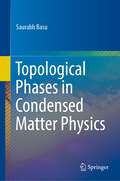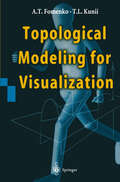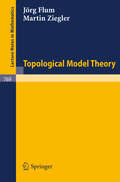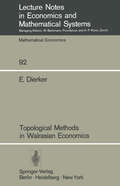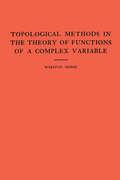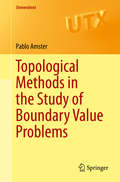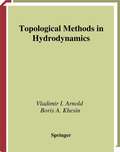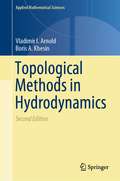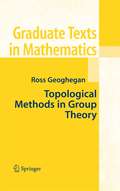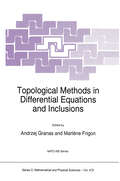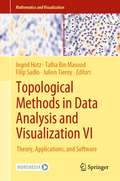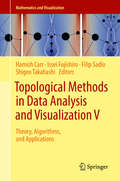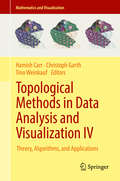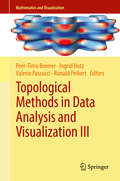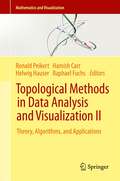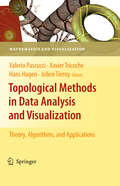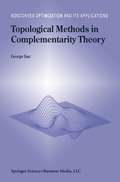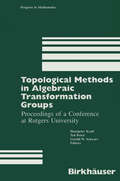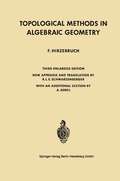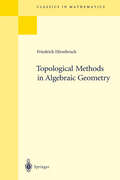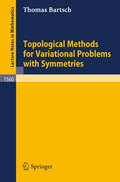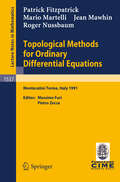- Table View
- List View
Topological Phases in Condensed Matter Physics
by Saurabh BasuThe book is mainly designed for post-graduate students to learn modern-day condensed matter physics. While emphasizing an experiment called the ‘Quantum Hall effect’, it introduces the subject of 'Topology' and how the topological invariants are related to the quantization of the Hall plateaus. Thus, the content tries to deliver an account of the topological aspects of materials that have shaped the study of condensed matter physics in recent times. The subject is often quite involved for a student to grasp the fundamentals and relate them to physical phenomena. Further, these topics are mostly left out of the undergraduate curriculum, although they often require a simplistic view of the concepts involved to be presented pedagogically. The book contains examples, worked-out concepts, important derivations, diagrams for illustration, etc. to aid the understanding of the students. The book also emphasizes the experimental discoveries that put the subject in its perspective and elaborate on the applications which are likely to be of interest to scientists and engineers.
Topological Obstructions to Stability and Stabilization: History, Recent Advances and Open Problems (SpringerBriefs in Electrical and Computer Engineering)
by Wouter Jongeneel Emmanuel MoulayThis open access book provides a unified overview of topological obstructions to the stability and stabilization of dynamical systems defined on manifolds and an overview that is self-contained and accessible to the control-oriented graduate student. The authors review the interplay between the topology of an attractor, its domain of attraction, and the underlying manifold that is supposed to contain these sets. They present some proofs of known results in order to highlight assumptions and to develop extensions, and they provide new results showcasing the most effective methods to cope with these obstructions to stability and stabilization. Moreover, the book shows how Borsuk’s retraction theory and the index-theoretic methodology of Krasnosel’skii and Zabreiko underlie a large fraction of currently known results. This point of view reveals important open problems, and for that reason, this book is of interest to any researcher in control, dynamical systems, topology, or related fields.
Topological Nonlinear Analysis II: Degree, Singularity and variations (Progress in Nonlinear Differential Equations and Their Applications #27)
by Michele Matzeu Alfonso VignoliThe main purpose of the present volume is to give a survey of some of the most significant achievements obtained by topological methods in nonlin ear analysis during the last three decades. It is intended, at least partly, as a continuation of Topological Nonlinear Analysis: Degree, Singularity and Varia tions, published in 1995. The survey articles presented are concerned with three main streams of research, that is topological degree, singularity theory and variational methods, They reflect the personal taste of the authors, all of them well known and distinguished specialists. A common feature of these articles is to start with a historical introduction and conclude with recent results, giving a dynamic picture of the state of the art on these topics. Let us mention the fact that most of the materials in this book were pre sented by the authors at the "Second Topological Analysis Workshop on Degree, Singularity and Variations: Developments of the Last 25 Years," held in June 1995 at Villa Tuscolana, Frascati, near Rome. Michele Matzeu Alfonso Vignoli Editors Topological Nonlinear Analysis II Degree, Singularity and Variations Classical Solutions for a Perturbed N-Body System Gianfausto Dell 'A ntonio O. Introduction In this review I shall consider the perturbed N-body system, i.e., a system composed of N point bodies of masses ml, ... mN, described in cartesian co ordinates by the system of equations (0.1) where f) V'k,m == -£l--' m = 1, 2, 3.
Topological Nonlinear Analysis: Degree, Singularity, and Variations (Progress in Nonlinear Differential Equations and Their Applications #15)
by Michele Matzeu Alfonso VignoliTopological tools in Nonlinear Analysis had a tremendous develop ment during the last few decades. The three main streams of research in this field, Topological Degree, Singularity Theory and Variational Meth ods, have lately become impetuous rivers of scientific investigation. The process is still going on and the achievements in this area are spectacular. A most promising and rapidly developing field of research is the study of the role that symmetries play in nonlinear problems. Symmetries appear in a quite natural way in many problems in physics and in differential or symplectic geometry, such as closed orbits for autonomous Hamiltonian systems, configurations of symmetric elastic plates under pressure, Hopf Bifurcation, Taylor vortices, convective motions of fluids, oscillations of chemical reactions, etc . . . Some of these problems have been tackled recently by different techniques using equivariant versions of Degree, Singularity and Variations. The main purpose of the present volume is to give a survey of some of the most significant achievements obtained by topological methods in Nonlinear Analysis during the last two-three decades. The survey articles presented here reflect the personal taste and points of view of the authors (all of them well-known and distinguished specialists in their own fields) on the subject matter. A common feature of these papers is that of start ing with an historical introductory background of the different disciplines under consideration and climbing up to the heights of the most recent re sults.
Topological Modeling for Visualization
by Anatolij T. Fomenko Tosiyasu L. KuniiThe flood of information through various computer networks such as the In ternet characterizes the world situation in which we live. Information worlds, often called virtual spaces and cyberspaces, have been formed on computer networks. The complexity of information worlds has been increasing almost exponentially through the exponential growth of computer networks. Such nonlinearity in growth and in scope characterizes information worlds. In other words, the characterization of nonlinearity is the key to understanding, utiliz ing and living with the flood of information. The characterization approach is by characteristic points such as peaks, pits, and passes, according to the Morse theory. Another approach is by singularity signs such as folds and cusps. Atoms and molecules are the other fundamental characterization ap proach. Topology and geometry, including differential topology, serve as the framework for the characterization. Topological Modeling for Visualization is a textbook for those interested in this characterization, to understand what it is and how to do it. Understanding is the key to utilizing information worlds and to living with the changes in the real world. Writing this textbook required careful preparation by the authors. There are complex mathematical concepts that require designing a writing style that facilitates understanding and appeals to the reader. To evolve a style, we set as a main goal of this book the establishment of a link between the theoretical aspects of modern geometry and topology, on the one hand, and experimental computer geometry, on the other.
Topological Methods in Walrasian Economics (Lecture Notes in Economics and Mathematical Systems #92)
by E. DierkerIn winter 71/72 I held a seminar on general equilibrium theory for a jOint group of students in mathematics and in econo mics at the university of Bonn , w.Germany1~ The economists , how ever , had a mathematical background well above the average • Most of the material treated in that seminar is described in these notes. The connection between smooth preferences and smooth demand func tions [ see Debreu (1972) ] and regular economies based on agents with smooth preferences are not presented here • Some pedagogical difficulties arose from the fact that elementary knowledge of algebraic topology is not assumed although it is helpful and indeed necessary to make some arguments precise • It is only a minor restriction , at present , that functional ana lysis is not used • But with the development of the theory more economic questions will be considered in their natural infinite dimensional setting • Economic knowledge is not required , but especially a reader without economic background will gain much by reading Debreu's classic "Theory of Value" (1959) • Although the formulation of our economic problem uses a map between Euclidean spaces only , we shall also consider ma- folds • Manifolds appear in our situation because inverse images under differentiable mappings between Euclidean spaces are very often differentiable manifolds • ( Under differentiability assump tions , for instance , the graph of the equilibrium set correspon
Topological Methods in the Theory of Functions of a Complex Variable. (AM-15), Volume 15
by Marston MorseThe description for this book, Topological Methods in the Theory of Functions of a Complex Variable. (AM-15), Volume 15, will be forthcoming.
Topological Methods in the Study of Boundary Value Problems (Universitext)
by Pablo AmsterThis textbook is devoted to the study of some simple but representative nonlinear boundary value problems by topological methods. The approach is elementary, with only a few model ordinary differential equations and applications, chosen in such a way that the student may avoid most of the technical difficulties and focus on the application of topological methods. Only basic knowledge of general analysis is needed, making the book understandable to non-specialists. The main topics in the study of boundary value problems are present in this text, so readers with some experience in functional analysis or differential equations may also find some elements that complement and enrich their tools for solving nonlinear problems. In comparison with other texts in the field, this one has the advantage of a concise and informal style, thus allowing graduate and undergraduate students to enjoy some of the beauties of this interesting branch of mathematics. Exercises and examples are included throughout the book, providing motivation for the reader.
Topological Methods in Hydrodynamics (Applied Mathematical Sciences #125)
by Vladimir I. Arnold Boris A. KhesinThe first monograph to treat topological, group-theoretic, and geometric problems of ideal hydrodynamics and magnetohydrodynamics from a unified point of view. It describes the necessary preliminary notions both in hydrodynamics and pure mathematics with numerous examples and figures. The book is accessible to graduates as well as pure and applied mathematicians working in hydrodynamics, Lie groups, dynamical systems, and differential geometry.
Topological Methods in Hydrodynamics (Applied Mathematical Sciences #125)
by Vladimir I. Arnold Boris A. KhesinThe first monograph to treat topological, group-theoretic, and geometric problems of ideal hydrodynamics and magnetohydrodynamics from a unified point of view. It describes the necessary preliminary notions both in hydrodynamics and pure mathematics with numerous examples and figures. The book is accessible to graduates as well as pure and applied mathematicians working in hydrodynamics, Lie groups, dynamical systems, and differential geometry.
Topological Methods in Group Theory (Graduate Texts in Mathematics #243)
by Ross GeogheganThis book is about the interplay between algebraic topology and the theory of infinite discrete groups. It is a hugely important contribution to the field of topological and geometric group theory, and is bound to become a standard reference in the field. To keep the length reasonable and the focus clear, the author assumes the reader knows or can easily learn the necessary algebra, but wants to see the topology done in detail. The central subject of the book is the theory of ends. Here the author adopts a new algebraic approach which is geometric in spirit.
Topological Methods in Differential Equations and Inclusions (Nato Science Series C: #472)
by Gert SabidussiThe papers collected in this volume are contributions to the 33rd session of the Seminaire de Mathematiques Superieures (SMS) on "Topological Methods in Differential Equations and Inclusions". This session of the SMS took place at the Universite de Montreal in July 1994 and was a NATO Advanced Study Institute (ASI). The aim of the ASI was to bring together a considerable group of young researchers from various parts of the world and to present to them coherent surveys of some of the most recent advances in this area of Nonlinear Analysis. During the meeting 89 mathematicians from 20 countries have had the opportunity to get acquainted with various aspects of the subjects treated in the lectures as well as the chance to exchange ideas and learn about new problems arising in the field. The main topics teated in this ASI were the following: Fixed point theory for single- and multi-valued mappings including topological degree and its generalizations, and topological transversality theory; existence and multiplicity results for ordinary differential equations and inclusions; bifurcation and stability problems; ordinary differential equations in Banach spaces; second order differential equations on manifolds; the topological structure of the solution set of differential inclusions; effects of delay perturbations on dynamics of retarded delay differential equations; dynamics of reaction diffusion equations; non smooth critical point theory and applications to boundary value problems for quasilinear elliptic equations.
Topological Methods in Data Analysis and Visualization VI: Theory, Applications, and Software (Mathematics and Visualization)
by Ingrid Hotz Talha Bin Masood Filip Sadlo Julien TiernyThis book is a result of a workshop, the 8th of the successful TopoInVis workshop series, held in 2019 in Nyköping, Sweden. The workshop regularly gathers some of the world’s leading experts in this field. Thereby, it provides a forum for discussions on the latest advances in the field with a focus on finding practical solutions to open problems in topological data analysis for visualization. The contributions provide introductory and novel research articles including new concepts for the analysis of multivariate and time-dependent data, robust computational approaches for the extraction and approximations of topological structures with theoretical guarantees, and applications of topological scalar and vector field analysis for visualization. The applications span a wide range of scientific areas comprising climate science, material sciences, fluid dynamics, and astronomy. In addition, community efforts with respect to joint software development are reported and discussed.
Topological Methods in Data Analysis and Visualization V: Theory, Algorithms, and Applications (Mathematics and Visualization)
by Hamish Carr Issei Fujishiro Filip Sadlo Shigeo TakahashiThis collection of peer-reviewed workshop papers provides comprehensive coverage of cutting-edge research into topological approaches to data analysis and visualization. It encompasses the full range of new algorithms and insights, including fast homology computation, comparative analysis of simplification techniques, and key applications in materials and medical science. The book also addresses core research challenges such as the representation of large and complex datasets, and integrating numerical methods with robust combinatorial algorithms. In keeping with the focus of the TopoInVis 2017 Workshop, the contributions reflect the latest advances in finding experimental solutions to open problems in the sector. They provide an essential snapshot of state-of-the-art research, helping researchers to keep abreast of the latest developments and providing a basis for future work. Gathering papers by some of the world’s leading experts on topological techniques, the book represents a valuable contribution to a field of growing importance, with applications in disciplines ranging from engineering to medicine.
Topological Methods in Data Analysis and Visualization IV: Theory, Algorithms, and Applications (Mathematics and Visualization)
by Hamish Carr Christoph Garth Tino WeinkaufThis book presents contributions on topics ranging from novel applications of topological analysis for particular problems, through studies of the effectiveness of modern topological methods, algorithmic improvements on existing methods, and parallel computation of topological structures, all the way to mathematical topologies not previously applied to data analysis. Topological methods are broadly recognized as valuable tools for analyzing the ever-increasing flood of data generated by simulation or acquisition. This is particularly the case in scientific visualization, where the data sets have long since surpassed the ability of the human mind to absorb every single byte of data. The biannual TopoInVis workshop has supported researchers in this area for a decade, and continues to serve as a vital forum for the presentation and discussion of novel results in applications in the area, creating a platform to disseminate knowledge about such implementations throughout and beyond the community. The present volume, resulting from the 2015 TopoInVis workshop held in Annweiler, Germany, will appeal to researchers in the fields of scientific visualization and mathematics, domain scientists with an interest in advanced visualization methods, and developers of visualization software systems.
Topological Methods in Data Analysis and Visualization III: Theory, Algorithms, and Applications (Mathematics and Visualization)
by Peer-Timo Bremer Ingrid Hotz Valerio Pascucci Ronald PeikertThis collection of peer-reviewed conference papers provides comprehensive coverage of cutting-edge research in topological approaches to data analysis and visualization. It encompasses the full range of new algorithms and insights, including fast homology computation, comparative analysis of simplification techniques, and key applications in materials and medical science. The volume also features material on core research challenges such as the representation of large and complex datasets and integrating numerical methods with robust combinatorial algorithms.Reflecting the focus of the TopoInVis 2013 conference, the contributions evince the progress currently being made on finding experimental solutions to open problems in the sector. They provide an inclusive snapshot of state-of-the-art research that enables researchers to keep abreast of the latest developments and provides a foundation for future progress. With papers by some of the world’s leading experts in topological techniques, this volume is a major contribution to the literature in a field of growing importance with applications in disciplines that range from engineering to medicine.
Topological Methods in Data Analysis and Visualization II: Theory, Algorithms, and Applications (Mathematics and Visualization)
by Ronald Peikert Helwig Hauser Hamish Carr Raphael FuchsWhen scientists analyze datasets in a search for underlying phenomena, patterns or causal factors, their first step is often an automatic or semi-automatic search for structures in the data. Of these feature-extraction methods, topological ones stand out due to their solid mathematical foundation. Topologically defined structures—as found in scalar, vector and tensor fields—have proven their merit in a wide range of scientific domains, and scientists have found them to be revealing in subjects such as physics, engineering, and medicine. Full of state-of-the-art research and contemporary hot topics in the subject, this volume is a selection of peer-reviewed papers originally presented at the fourth Workshop on Topology-Based Methods in Data Analysis and Visualization, TopoInVis 2011, held in Zurich, Switzerland. The workshop brought together many of the leading lights in the field for a mixture of formal presentations and discussion. One topic currently generating a great deal of interest, and explored in several chapters here, is the search for topological structures in time-dependent flows, and their relationship with Lagrangian coherent structures. Contributors also focus on discrete topologies of scalar and vector fields, and on persistence-based simplification, among other issues of note. The new research results included in this volume relate to all three key areas in data analysis—theory, algorithms and applications.
Topological Methods in Data Analysis and Visualization: Theory, Algorithms, and Applications (Mathematics and Visualization)
by Valerio Pascucci Xavier Tricoche Hans Hagen Julien TiernyTopology-based methods are of increasing importance in the analysis and visualization of datasets from a wide variety of scientific domains such as biology, physics, engineering, and medicine. Current challenges of topology-based techniques include the management of time-dependent data, the representation of large and complex datasets, the characterization of noise and uncertainty, the effective integration of numerical methods with robust combinatorial algorithms, etc. . The editors have brought together the most prominent and best recognized researchers in the field of topology-based data analysis and visualization for a joint discussion and scientific exchange of the latest results in the field. This book contains the best 20 peer-reviewed papers resulting from the discussions and presentations at the third workshop on "Topological Methods in Data Analysis and Visualization", held 2009 in Snowbird, Utah, US. The 2009 "TopoInVis" workshop follows the two successful workshops in 2005 (Slovakia) and 2007 (Germany).
Topological Methods in Complementarity Theory (Nonconvex Optimization and Its Applications #41)
by G. IsacComplementarity theory is a new domain in applied mathematics and is concerned with the study of complementarity problems. These problems represent a wide class of mathematical models related to optimization, game theory, economic engineering, mechanics, fluid mechanics, stochastic optimal control etc. The book is dedicated to the study of nonlinear complementarity problems by topological methods. Audience: Mathematicians, engineers, economists, specialists working in operations research and anybody interested in applied mathematics or in mathematical modeling.
Topological Methods in Algebraic Transformation Groups: Proceedings of a Conference at Rutgers University (Progress in Mathematics #80)
by KraftIn recent years, there has been increasing interest and activity in the area of group actions on affine and projective algebraic varieties. Tech niques from various branches of mathematics have been important for this study, especially those coming from the well-developed theory of smooth compact transformation groups. It was timely to have an interdisciplinary meeting on these topics. We organized the conference "Topological Methods in Alg~braic Transformation Groups," which was held at Rutgers University, 4-8 April, 1988. Our aim was to facilitate an exchange of ideas and techniques among mathematicians studying compact smooth transformation groups, alge braic transformation groups and related issues in algebraic and analytic geometry. The meeting was well attended, and these Proceedings offer a larger audience the opportunity to benefit from the excellent survey and specialized talks presented. The main topics concerned various as pects of group actions, algebraic quotients, homogeneous spaces and their compactifications. The meeting was made possible by support from Rutgers University and the National Science Foundation. We express our deep appreciation for this support. We also thank Annette Neuen for her assistance with the technical preparation of these Proceedings.
Topological Methods in Algebraic Geometry (Grundlehren der mathematischen Wissenschaften #131)
by Friedrich HirzebruchTopological Methods in Algebraic Geometry: Reprint of the 1978 Edition (Classics In Mathematics Ser.)
by Friedrich HirzebruchIn recent years new topological methods, especially the theory of sheaves founded by J. LERAY, have been applied successfully to algebraic geometry and to the theory of functions of several complex variables. H. CARTAN and J. -P. SERRE have shown how fundamental theorems on holomorphically complete manifolds (STEIN manifolds) can be for mulated in terms of sheaf theory. These theorems imply many facts of function theory because the domains of holomorphy are holomorphically complete. They can also be applied to algebraic geometry because the complement of a hyperplane section of an algebraic manifold is holo morphically complete. J. -P. SERRE has obtained important results on algebraic manifolds by these and other methods. Recently many of his results have been proved for algebraic varieties defined over a field of arbitrary characteristic. K. KODAIRA and D. C. SPENCER have also applied sheaf theory to algebraic geometry with great success. Their methods differ from those of SERRE in that they use techniques from differential geometry (harmonic integrals etc. ) but do not make any use of the theory of STEIN manifolds. M. F. ATIYAH and W. V. D. HODGE have dealt successfully with problems on integrals of the second kind on algebraic manifolds with the help of sheaf theory. I was able to work together with K. KODAIRA and D. C. SPENCER during a stay at the Institute for Advanced Study at Princeton from 1952 to 1954.
Topological Methods for Variational Problems with Symmetries (Lecture Notes in Mathematics #1560)
by Thomas BartschSymmetry has a strong impact on the number and shape of solutions to variational problems. This has been observed, for instance, in the search for periodic solutions of Hamiltonian systems or of the nonlinear wave equation; when one is interested in elliptic equations on symmetric domains or in the corresponding semiflows; and when one is looking for "special" solutions of these problems. This book is concerned with Lusternik-Schnirelmann theory and Morse-Conley theory for group invariant functionals. These topological methods are developed in detail with new calculations of the equivariant Lusternik-Schnirelmann category and versions of the Borsuk-Ulam theorem for very general classes of symmetry groups. The Morse-Conley theory is applied to bifurcation problems, in particular to the bifurcation of steady states and hetero-clinic orbits of O(3)-symmetric flows; and to the existence of periodic solutions nearequilibria of symmetric Hamiltonian systems. Some familiarity with the usualminimax theory and basic algebraic topology is assumed.
Topological Methods for Ordinary Differential Equations: Lectures given at the 1st Session of the Centro Internazionale Matematico Estivo (C.I.M.E.) held in Montecatini Terme, Italy, June 24-July 2, 1991 (Lecture Notes in Mathematics #1537)
by Patrick Fitzpatrick Mario Martelli Jean Mawhin Roger NussbaumThe volume contains the texts of four courses, given by the authors at a summer school that sought to present the state of the art in the growing field of topological methods in the theory of o.d.e. (in finite and infinitedimension), and to provide a forum for discussion of the wide variety of mathematical tools which are involved. The topics covered range from the extensions of the Lefschetz fixed point and the fixed point index on ANR's, to the theory of parity of one-parameter families of Fredholm operators, and from the theory of coincidence degree for mappings on Banach spaces to homotopy methods for continuation principles. CONTENTS: P. Fitzpatrick: The parity as an invariant for detecting bifurcation of the zeroes of one parameter families of nonlinear Fredholm maps.- M. Martelli: Continuation principles and boundary value problems.- J. Mawhin: Topological degree and boundary value problems for nonlinear differential equations.- R.D. Nussbaum: The fixed point index and fixed point theorems.
